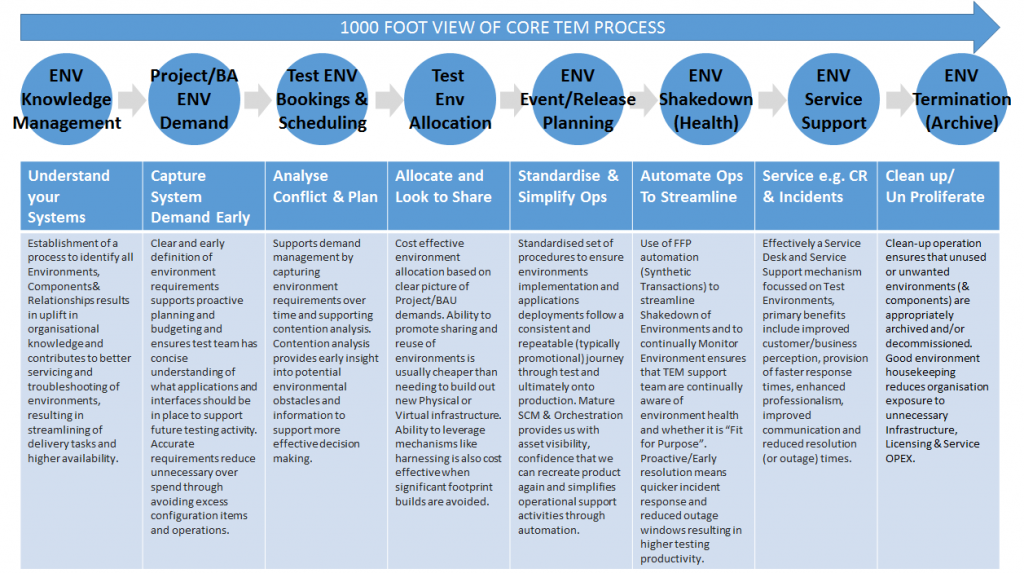Chronologically we believe you should:
- Establish System Knowledge
- Capture Project/BAU Demand for your Systems
- Analyse Conflict & Plan Accordingly
- Allocate Environments (& look to Share)
- Standardise & Simplify Environment TestOps
- Automate Environment Tasks e.g. Shakedown
- Ensure you have Service Support (ITSM)
- Terminate/Clean Up Environments after Use
Implementation of a process similar to above will uplift your Environment IP, promote proactive management behaviour, mature your underlying operations, streamline the service and also ensure effective Infrastructure housekeeping (thus reduce/control costs).
Download TEM Process PDF.
Process Glossary
1 Understand your Systems
Establishment of a process to identify all Environments, Components& Relationships results in uplift in organisational knowledge and contributes to better servicing and troubleshooting of environments, resulting in streamlining of delivery tasks and higher availability.
2 Capture System Demand Early
Clear and early definition of environment requirements supports proactive planning and budgeting and ensures test team has concise understanding of what applications and interfaces should be in place to support future testing activity. Accurate requirements reduce unnecessary over spend through avoiding excess configuration items and operations.
3 Analyse Conflict & Plan
Supports demand management by capturing environment requirements over time and supporting contention analysis. Contention analysis provides early insight into potential environmental obstacles and information to support more effective decision making.
4 Allocate & Look to Share
Cost effective environment allocation based on clear picture of Project/BAU demands. Ability to promote sharing and reuse of environments is usually cheaper than needing to build out new Physical or Virtual infrastructure. Ability to leverage mechanisms like harnessing is also cost effective when significant footprint builds are avoided.
5 Environment Event & Release Planning
Standardized set of procedures to ensure environments implementation and applications deployments follow a consistent and repeatable (typically promotional) journey through test and ultimately onto production. Mature Configuration Management & Orchestration provides us with asset visibility, confidence that we can recreate product again and simplifies operational support activities through automation.
6 Automate Operations to Streamline
Use of Fit-For-Purpose automation (Synthetic Transactions) to streamline Shakedown of Environments and to continually Monitor Environment ensures that TEM support team are continually aware of environment health and whether it is “Fit for Purpose”. Proactive/Early resolution means quicker incident response and reduced outage windows resulting in higher testing productivity.
7 Environment Service Support
Effectively a Service Desk and Service Support mechanism focused on Test Environments, primary benefits include improved customer/business perception, provision of faster response times, enhanced professionalism, improved communication and reduced resolution (or outage) times.
8 Cleanup/Un-Proliferate
Clean-up operation ensures that unused or unwanted environments (& components) are appropriately archived and/or decommissioned. Good environment housekeeping reduces organisation exposure to unnecessary Infrastructure, Licensing & Service OPEX.
Implementation of TEM Process
For those interested in taking this one step further, why not consider authoring a Test Environment Management Plan.
A plan, focused on Test / Non-Production Environments Management, that will promote a higher level of visibility across one’s test environments and operations and establish proactive controls to ensure they are effectively managed, used, shared, serviced and provisioned (or de-commissioned) efficiently.
Example Here: Test Environment Management Template
